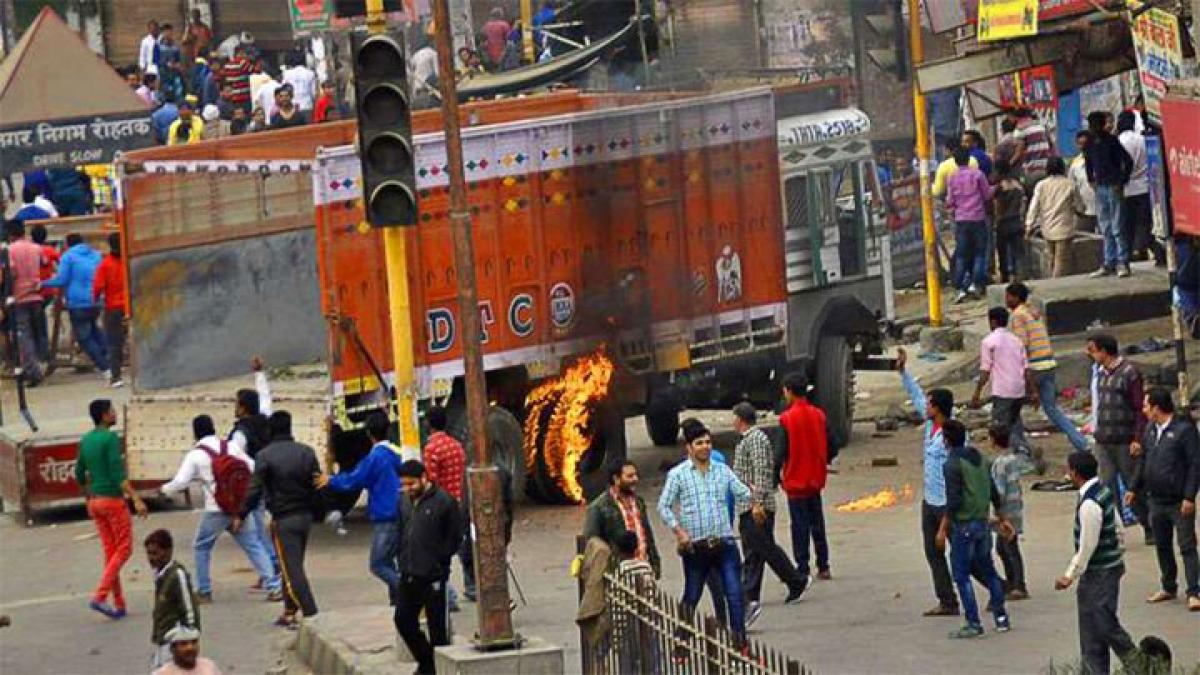Live
- Over 7,600 Syrians return from Turkiye in five days after Assad's downfall: minister
- Delhi BJP leaders stay overnight in 1,194 slum clusters
- Keerthy Suresh and Anthony Thattil Tie the Knot in a Christian Ceremony
- AAP, BJP making false promises to slum dwellers for votes: Delhi Congress
- 'Vere Level Office' Review: A Refreshing Take on Corporate Life with Humor and Heart
- Libya's oil company declares force majeure at key refinery following clashes
- Illegal Rohingyas: BJP seeks Assembly session to implement NRC in Delhi
- Philippines orders full evacuation amid possible volcanic re-eruption
- Government Prioritizes Welfare of the Poor, says Dola Sri Bala Veeranjaneyaswamy
- Two Russian oil tankers with 29 on board damaged due to bad weather
Just In

Square-jawed, cleft chin and hair untidily spiked, Vikas Thakaran glowered as he explained why he was here in this scrum of young men blocking Bakhtawar chowk, 30 km southwest of India’s capital, part of a violent week-long agitation that has left 12 dead, vehicles and railway stations burnt, and the army deployed.
Organised industry added 5,00,000 jobs in 2014; India needs more than a million a month
New Delhi: Square-jawed, cleft chin and hair untidily spiked, Vikas Thakaran glowered as he explained why he was here in this scrum of young men blocking Bakhtawar chowk, 30 km southwest of India’s capital, part of a violent week-long agitation that has left 12 dead, vehicles and railway stations burnt, and the army deployed.
Thakaran, 24, is a computer-science engineer, but he is unemployed. “I applied for government jobs four-five times, many times elsewhere, but I didn’t get through,” he told IndiaSpend. We found many educated, angry and either unemployed young men like Thakaran, or those unable to find a job commensurate with their aspirations and education, among the thousands of protestors from a caste group that many say has no reason to protest.
Traditional landowners, the Jats are a powerful Hindu caste now demanding classification as a “backward” caste - a contention rejected last year by the Supreme Court so that government jobs can be reserved for them. However, an IndiaSpend analysis of employment data and evaluation of aspirations of young Jats revealed that the protests are manifestations of India’s slow, inadequate job-creation and a failing education system creating thousands of “unemployable” graduates.
This disconnect between education, aspirations and jobs explains similar demands to be classified as “backward” and “other-backward-caste (OBC)” by socially powerful caste groups - Gujjars (Rajasthan), Marathas (Maharashtra), Patels (Gujarat) and Kapus (Andhra Pradesh), among others - struggling to find satisfactory employment.
Organised industry added 500,000 jobs in 2014; India needs more than a million a month. Over 30 years, India generated no more than seven million jobs every year, with only a fraction being the kinds of jobs the young Jats desire. This is why protestors across India demand secure government jobs; it is why engineers and doctors throng job openings for peons, clerks and constables (as they did in Uttar Pradesh last year, when 2.3 million applied for 368 positions of peons).
As we also reported, new employment data indicate two disquieting trends. One, a slowdown in employment in the formal, organised sector (which in any case employs only 12 per cent of India’s labour force), the prime staging ground of Prime Minister Narendra Modi’s ‘Make in India’ programme. In Indian factories, more than 4,00,000 people lost their jobs during the financial year 2012-13, according to government data.
The other trend is that this slowdown hides a larger, long-term trend: India Inc is automating and squeezing more output from its workers and so needs fewer of them. In isolation, the latest government data show that organised industry added nearly 5,00,000 jobs in 2013-14. Unemployment in India, according to labour ministry data, is less than five percent, but these data do not reflect under-, partial- or disguised-employment.
No more than 17 per cent of all Indians were wage earners, as a 2013-14 labour ministry report acknowledged, with no more than 60 per cent of those above 15 years old who sought work over the year getting it (more than 46 per cent in urban India did not find work). “What India needs annually is not just 23 or 24 million jobs but livelihoods,” said economist Ajit Ranade.
He said job opportunities would come only with new investments and enterprises. Jat youth on the streets do not want informal-sector jobs, as our interviews indicated, but here too, as IndiaSpend has reported, employment declined by six per cent since 2004-05-and this is the sector that offers the most jobs - 340 million.
Ranade said the government should focus on small and medium enterprises, revamp infrastructure, rationalise tax structures, revive skills in traditional industries, set up technical training institutes producing skilled workers and ensure ease of doing business.
By Himadri Ghosh & Nikhil Babu

© 2024 Hyderabad Media House Limited/The Hans India. All rights reserved. Powered by hocalwire.com







